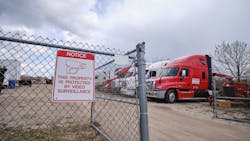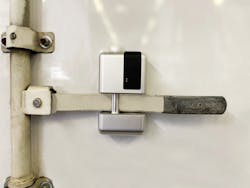There’s nothing new about thieves targeting commercial vehicles and their freight. But the theft of cargo is on the rise. And even when not holding cargo, commercial vehicles’ valuable components, like catalytic converters, still make them prime targets. Now more than ever, management must consider the risk of theft wherever these trucks are parked and take preventative measures by adding cameras to detect and implicate any criminals trying to pilfer your goods and assets.
First, let’s look at the negative trend. Data from CargoNet, a theft prevention and recovery network, indicates a yearly 17% increase in thefts involving a semi-truck or semi-trailer, with cargo thefts increasing by 20% year-over-year, from 2021 to 2022. CargoNet also reported that almost 1,800 theft claims were made by its members in 2022. That 15% increase from 2021 totaled a more than $223 million loss.
Read more: Preventive maintenance for commercial vehicle doors and locksAccording to Danny Ramon, intelligence and response manager at logistics solution provider Overhaul, there’s an increase in high-value pilferages when cargo is stolen from a trailer, as opposed to the trailer itself being stolen. What was once a typical 10% or so pilferage of a 53-ft. trailer is now seen with nearly 90% or more of the cargo stolen.
Chris Corlee, product management director at trailer technology provider Orbcomm, said losses from cargo thefts in the U.S. are estimated at over $30 billion annually. The FBI has stated in the past that the number is about $15-30 billion annually.
“While it’s challenging to get accurate data on the exact number of cargo theft incidents, industry reports suggest that the number of thefts has been increasing in recent years,” Corlee says. “In the United States and Canada, thefts are typically attempted when trucks are parked at insecure locations, either breaking into the trailer or taking the vehicle. Hijacking remains the leading type of cargo theft in North America, accounting for 69% of all recorded cases in 2020. Idle times across the industry drove a significant uptick in cargo theft at rest.”
Location and part targets
Cargo is not the only thing thieves are after. The vital components of commercial vehicles, particularly catalytic converters, are also fair game.
“In the United States, catalytic converter thefts have skyrocketed, with some areas reporting more than a 400% increase in thefts between 2019 and 2020,” noted Brian Joseph, Jr., operations manager at an Akron, Ohio-based body shop called Fleet Fast.
Joseph, Jr. said one reason for the rise in catalytic converter thefts from fleets is the increase in value for precious metals like platinum, palladium, and rhodium. He noted that thieves target fleets and repair shops, and that not investing in parking and security cameras can be quite costly.
“We experienced theft of a DPF system before we started utilizing secured lots for overflow parking,” he said. “That was an expensive mistake.”
Some of these thefts lean on the more dangerous side, with Joseph, Jr. recalling stories locally and nationally about thieves using weapons such as firearms to forcefully take catalytic converters and DPF systems during the day.
Phillips Connect CEO Rob Phillips agreed there is a rise in cargo and catalytic converter thefts in recent years, with thieves targeting valuable commodities such as electronics, pharmaceuticals, and metals.
Phillips Connect specializes in trailer telematics and connectivity, and its line of SmartLock products focus on ensuring only designated personnel can move or unload a trailer.
“Fleets should be aware of this trend and take steps to secure their cargo and vehicles,” Phillips says. “Cargo theft has become increasingly common, and thieves are often using more creative and sophisticated methods to carry out their crimes. A thief removing and then welding back swing doors is a prime example of this. Thieves may also use hydraulic tools or cutting torches to gain access to cargo or other valuable parts of the truck.”
Corlee said there are other items on trucks thieves are also interested in, such as fuel and tires.
“Fuel theft is an ongoing issue faced by fleets, often occurring with assistance from internal resources,” he noted. “Fuel is siphoned from the truck’s tank and sold, or on occasion, company-provided cards are used to fuel other vehicles.”
This is Part One of a two-part story. In Part Two, we discuss how to curb cargo theft with technology.
What to do if a theft occurs
Rob Phillips, CEO of Phillips Connect, said there are several best practices to follow after a theft has occurred.
- Secure the area: If possible, secure the area to prevent further loss or damage.
- Preserve evidence: Avoid disturbing any potential evidence and document the scene as thoroughly as possible, including taking photos or videos.
- Notify stakeholders: Notify any relevant stakeholders, such as the fleet owner, insurance company, and cargo owners.
- Review security measures: Review the security measures in place to identify any weaknesses.
- Cooperate with law enforcement: Provide police with any information that may be helpful in their investigation.
- Conduct an investigation: Conduct an internal investigation on how the theft occurred and how to prevent it.
Taking these steps can help minimize the impact of a theft and increase the chances of recovering assets.
About the Author

Faith Boone
Faith Boone has more than 15 years of experience as a journalist, public relations professional, strategic marketer, and entrepreneur. She has held several positions within the communications industry, and also enjoys giving back to the community through her work with various non-profit organizations. She is the founder of Boone Logic, a Cleveland-based content development and marketing consultancy.

